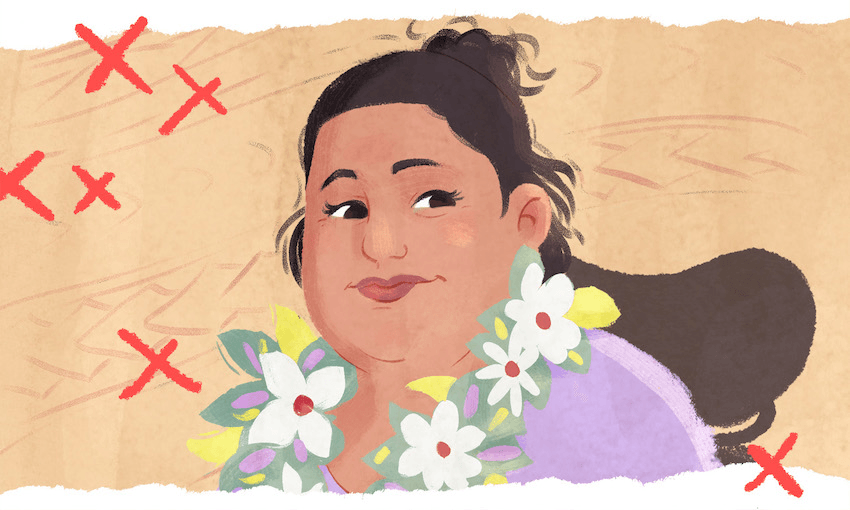Artist and dancer Lusi Faiva was two when, diagnosed with cerebral palsy, she was taken to live in an institution for people with intellectual disabilities. She spent five years at the Kimberley Centre, experiencing neglect, terrible loneliness, alienation from her Sāmoan heritage and a sense of entrapment which has inspired a lifetime of seeking expression and freedom.
This article is part of The Quarter Million, exploring the Royal Commission of Inquiry into Abuse in State Care. Read the introduction here.
Illustrations by Munro Te Whata.
I am a proud Sāmoan woman. I am an artist, dancer and passionate freedom seeker.
I was two years old when I was diagnosed with cerebral palsy. There was little support for disabled children and their families back then. The doctor instructed my mum for me to go to an institution. He said, “it would be better this way”.
Soon after, I was moved to Kimberley Centre, a specialist hospital in Levin for the care of people with intellectual disabilities). I only remember small amount from my years at Kimberley. I was sharing a room with other children there. During the day, we sat in the recreational room but there were no activities going on — we hardly interacted with each other. In the shared space there were people of all ages with different disabilities. The institute felt dark and cold.
I did not know how to express myself. There were no tools or strategies offered to me to communicate with people around me so I could express what I wanted and needed. It was assumed that I did not have the mental capacity to communicate, and it was assumed that I had an intellectual disability. I was under five at this point but old enough to remember how trapped I felt in myself.
No one ever talked to me about my Sāmoan heritage. I felt like people didn’t know or care about my culture. Even if they did there was no recognition, interest or inclusion. There was no respect or effort to recognise me for who I was.
The only times that the nurses came on to the ward was to give us children our medicine and then they left. Once, I fell and broke my ankle because no one was watching me. If I had received better care then, my physical health would be better today. I never received any specialised support until I left the institute even though my mum was told that being there would be better for me. I think that institutions are not set up to care and look after the disabled people because they are built on a system that dehumanises disabled people.
Care was about medication, changing, showering and other very clinical procedures that don’t take into account needs such as human connection and affection.
Two sparks of light in a dark place
I can remember doing schooling at Kimberley from the age of about five. There were two staff members who were a couple, they visited Kimberley every day and they were the only ones who taught us kids. They recognised that I was switched on, and started teaching me how to read and write and to express myself finally after I was five. It was strange to see words in the beginning. But as the time went on I could understand what they were teaching me. I was a fast learner. I had a blackboard with chalk that I was able to hold. They taught me how to spell things. They were kind and gave their time to come and play with us. It was the only time we did activities like games and drawing. I learned ways to express myself. I remember that couple dearly.
While I was in the Kimberley Centre, my mum never visited me. The first time she came was when she came to take me home. I didn’t know who she was and I felt nervous. The two staff members, who taught me how to express myself, kept in touch with Mum and convinced her to take me home. I felt upset to leave Kimberley because I didn’t want to leave them. I did not see them for a long time after I left Kimberley yet they still remain significant people in my life. Their regular interactions with me taught me that I was someone, I was Lusi and I deserved to be loved.
Life after Kimberley
Returning to live with Mum at the age of seven was challenging. It felt like we were strangers and it has been really hard to make up for the years we missed out on with each other. At the time, she was in an abusive relationship. Living with her boyfriend’s family was so confronting and scary. Mum had only been in New Zealand for eight years at this point and she was left alone without moral support. It was a tough time for her.
I liked going to school because it gave me a sense of normality. I could switch off from what was going on at home. I was interacting with other children and learning. But this came to a halt when we eventually had to escape from Mum’s boyfriend. We went to women’s refuge first. Then, while Mum was looking for a place to live for us, I was in a hospital. As I was coming to terms with my CP, the doctors decided to make me walk. I had a surgery to straighten out my legs and ankles, followed by rehabilitation. The doctors didn’t explain what they were doing with me. I felt like my body was being manipulated. They were working with my cerebral palsy as if it was disconnected from me and my feelings did not exist.
My mum came to pick me up at the end of the rehabilitation and we took a train to Auckland to stay with my auntie and her family. She had four-bedroom house with 15 people in it and everyone spoke Sāmoan. I went from not really understanding my Sāmoan identity nor hearing my language to being thrown into this rich but overwhelming space.
This transition required a lot of adjustment from me. I was receiving the cultural knowledge I had longed for but my Sāmoan family didn’t know about cerebral palsy and therefore didn’t know how to care for me. We only stayed with them for a short while, and we eventually moved to our own place in another suburb. While I was living with my auntie I went to a school for children with cerebral palsy and I stayed in the same school after we moved. They didn’t really teach us though because the school was focused on recreation and rehabilitation. Also none of the schools or education I received had good understanding of my culture.
When things were really hard at home with my family I sometimes wished that I hadn’t gone home. However, looking back now, I think that if I had stayed in Kimberley for any longer my life would have been worse. I wouldn’t have had the freedom that I later experienced to explore my own life. I wouldn’t be the Lusi I am today.
The fight for freedom
When I was 15, I joined an acting group. It was my first step towards exploring myself and what I wanted to do. Soon after, I started to rebel by partying with my friends. After a while of doing that, I decided that I wanted to explore how far I could push my personal boundaries, break free and be reckless by leaving home. It was risky and at times an unsafe way to live but I needed to feel this, explore this, in order to gain some autonomy on who I am and what I wanted to do with my life. This was life changing. I met similar people often broken by their own history, and, like me, seeking their own truths. These people became my family during this time — they got me.
Eventually, I had to return home for obvious reasons. I went flatting in a house run by a disability support service. They provided support workers so that I could do things I needed but I didn’t really like it there. I felt restricted and I wanted my freedom back. I moved out after a year to a state house, where I’ve lived ever since. I have support workers who come in mornings and nights now. Sometimes I feel scared living on my own because sometimes support workers don’t turn up and I get stuck. There was a lady who passed away alone who lived near my area, and sometimes I get scared it might happen to me. I feel like I don’t have control over this situation. This sense of fear and restriction brings me back to the memory of being in Kimberley.
I joined a dance group run for disabled people by disabled people when I was 28. I had no training, but I knew that this was my passion and I fell in love with the performance world. I feel free when I dance. To be honest, I still struggle with putting myself on the stage because I feel judged. But I put a facade on to be on the stage and I pour my heart into my performance. I express my identity through my dance. It brings me beautiful moments, movement, interactions, tears, love, and laughter.I need it to be real, and it can be challenging to get my moves right. Through dance, I have reconnected more strongly with my Sāmoan culture.
If I met myself in Kimberly, I believe that little Lusi would be happy seeing someone like her wanting to play alongside her. That little Lusi at Kimberley wanted to know she was important, loved and deserving of affection. That she was from a rich and vibrant Sāmoan heritage and she had so many strengths.
Being in care was like a slap in my face. There was no freedom of choice. I was lost. There was no acceptance from others that I needed freedom and acceptance of who I am as an individual. Living independently now is a source of freedom, but it has moments of good and bad. The support services are not resourced enough to be reliable when I need them urgently, even today. It frustrates me a lot. Care still fundamentally operates under a lack of respect for freedom and even basic human needs.
Lusi Faivi uses dance to connect with her culture and change perceptions about disability. She’s co-founder of Touch Compass, Hau Tipua Toi which creates opportunities for disabled people to have a platform to share their art.

